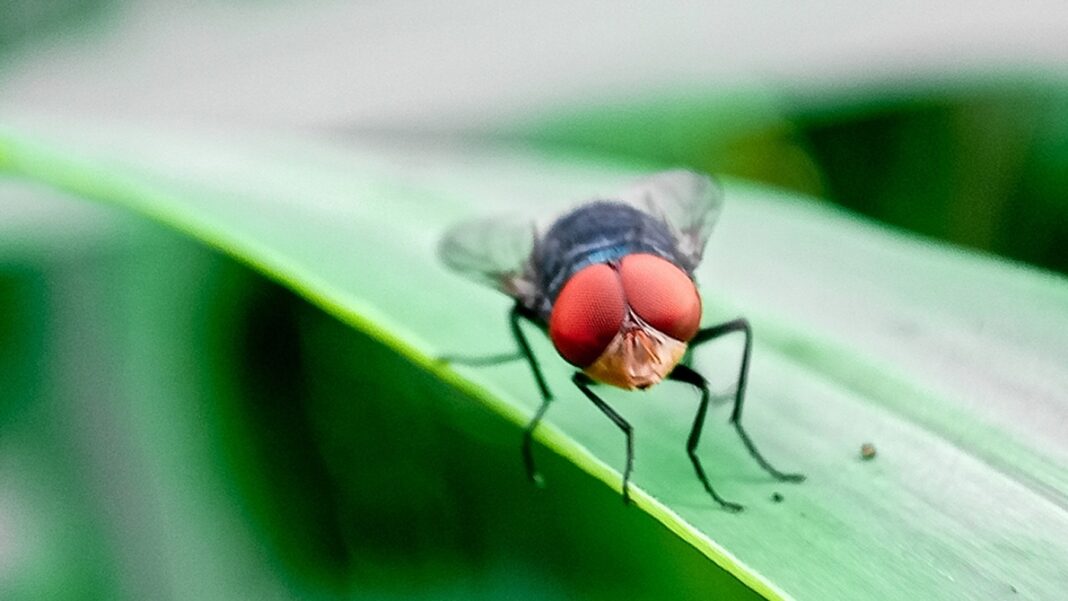“A threat to the nation’s beef supply has taken a dramatic turn, as the U.S. government announces an immediate halt to cattle imports from Mexico. The unprecedented measure comes in response to a shocking discovery: a flesh-eating maggot infestation has been found in Mexican cattle, raising alarm bells among American farmers, traders, and consumers. This sudden disruption in the global cattle trade has the potential to send shockwaves through the country’s agricultural sector, with far-reaching consequences for the economy and public health. As the U.S. Department of Agriculture takes swift action to protect its citizens, questions linger: how widespread is this infestation, and what does it mean for the future of Mexican-U.S. agricultural trade?”
U.S.-Mexico Livestock Trade Dispute: The New World Screwworm Threat

The recent surge in New World screwworm cases in Mexico and Central America has sparked a heated debate over the U.S.-Mexico livestock trade. The New World screwworm, a flesh-eating maggot, poses a significant threat to animal health and the economy, with the potential to cause widespread damage if left unchecked.
The New World screwworm is a fly larva that burrows into wounds or mucous membranes of animals, feeding on flesh and blood. If left untreated, the parasitic infection can kill a full-grown cow within one to two weeks.

The Aggressive Maggot: Understanding the New World Screwworm
The Flesh-Eating Parasite: Biology and Impact
The New World screwworm is a parasitic fly larva that belongs to the family Calliphoridae. It is characterized by its aggressive behavior, distinctive odor, and ability to burrow into animal tissues.
The life cycle of the New World screwworm consists of four stages: egg, larva, pupa, and adult. The female fly lays her eggs in the wound or mucous membrane of the host animal, and the larvae hatch within 24 hours.
The larvae feed on the flesh and blood of the host animal, causing significant damage and disfigurement. If left untreated, the parasitic infection can lead to septicemia, organ failure, and death.
The economic impact of a New World screwworm infestation cannot be overstated. According to a USDA analysis, a single outbreak in Texas affected over 1.4 million cattle and hundreds of thousands of sheep and goats, resulting in estimated losses of $1.8 billion.
The emotional toll of a New World screwworm infestation should not be underestimated either. The trauma and stress associated with losing an animal to this devastating disease can be severe and long-lasting.
- Loss of livestock: The New World screwworm can cause significant losses in livestock, leading to economic hardship for farmers and ranchers.
- Animal suffering: The parasitic infection can cause significant pain and suffering in animals, leading to a decline in their quality of life.
- Economic impact: The New World screwworm can have a devastating impact on local and national economies, leading to job losses and food shortages.

Historical Context: Past Efforts to Eradicate the Pest
The New World screwworm has been a significant problem for livestock producers for centuries. In the 1960s and 1970s, the U.S. and Mexico launched a joint effort to eradicate the pest using a strategy called Sterile Insect Technique (SIT).
SIT involves releasing large numbers of sterile male flies into the wild, which mate with female flies and prevent them from laying viable eggs. This strategy was highly effective in reducing the screwworm population and creating a “barrier zone” that protected the U.S. and Mexico from infestation.
However, the SIT program was eventually discontinued due to funding constraints and a decline in the screwworm population. As a result, the pest has made a comeback in recent years, with cases surging in parts of Central America and Mexico.
The current situation is a stark reminder of the need for a concerted effort to eradicate the New World screwworm once and for all. With the right combination of technology, funding, and coordination, it is possible to rid the world of this devastating pest and protect livestock producers from its devastating impact.
- Sterile Insect Technique (SIT): The SIT program used to control the screwworm population involved releasing large numbers of sterile male flies into the wild.
- Barriers to eradication: Funding constraints and a decline in the screwworm population led to the discontinuation of the SIT program.
- Current situation: The New World screwworm has made a comeback in recent years, with cases surging in parts of Central America and Mexico.
The Current Situation: Rising Cases in Mexico and Central America
The recent surge in New World screwworm cases in Mexico and Central America has raised concerns about the potential spread of the pest to the U.S.
Cases have been detected in remote farms in Mexico, approximately 700 miles from the U.S. border. The USDA has confirmed that the New World screwworm has been detected in several states, including Tamaulipas, Nuevo Leon, and Coahuila.
The situation is particularly concerning due to the close proximity of the affected areas to the U.S. border. If the pest were to spread, it could have devastating consequences for livestock producers and the economy.
The USDA and Mexican authorities are working closely to contain the outbreak and prevent the spread of the pest to other areas.
- Rising cases: The New World screwworm has been detected in several states in Mexico, including Tamaulipas, Nuevo Leon, and Coahuila.
- Potential spread: The pest has the potential to spread to other areas, including the U.S., if left unchecked.
- Containment efforts: The USDA and Mexican authorities are working closely to contain the outbreak and prevent the spread of the pest.
U.S. Response: Halting Cattle Imports from Mexico
In response to the rising cases of the New World screwworm in Mexico, the U.S. has taken steps to protect animal and human health by halting cattle imports from Mexico.
Agriculture Secretary Brooke Rollins made the decision to halt imports based on the potential risk to animal and human health. The decision is a precautionary measure to prevent the spread of the pest to other areas.
The ban will remain in place until a significant window of containment is achieved, according to the USDA. The agency is working closely with Mexican authorities to monitor the situation and prevent the spread of the pest.
The decision to halt cattle imports from Mexico is a proactive measure to protect animal and human health. It demonstrates the U.S. commitment to safeguarding the nation’s food supply and preventing the spread of disease.
- Halting imports: The U.S. has taken steps to protect animal and human health by halting cattle imports from Mexico.
- Potential risk: The decision is based on the potential risk to animal and human health posed by the New World screwworm.
- Precautionary measure: The ban is a precautionary measure to prevent the spread of the pest to other areas.
The Ban’s Impact: Economic and Trade Consequences
The U.S. government’s decision to halt cattle imports from Mexico has significant economic implications for both countries. The livestock industry is a significant contributor to the U.S. economy, and the ban is expected to have far-reaching consequences. According to the USDA, the livestock industry is worth over $100 billion annually, with cattle accounting for a significant portion of this amount. The ban is expected to affect:
- Cattle farmers and ranchers who rely on exports to Mexico
- The U.S. livestock industry, which will face increased competition from domestic producers
- The Mexican economy, which will lose a significant source of revenue
The long-term effects of the ban on trade relations between the two countries are also a concern. The U.S. and Mexico have a long history of trade cooperation, and the ban has the potential to strain this relationship. The two countries have worked together to combat the screwworm threat in the past, and the ban may make it more challenging to cooperate in the future.
Next Steps: Containment and Eradication Efforts
The U.S. and Mexican governments have announced plans to contain the screwworm population. The USDA has stated that it will work closely with its Mexican counterparts to implement measures to prevent the spread of the screwworm. These measures include:
- Increasing surveillance and monitoring of livestock population
- Implementing strict quarantine and testing protocols for imported livestock
- Conducting public awareness campaigns to educate farmers and ranchers about the risks of the screwworm
The importance of international cooperation in combating the screwworm threat cannot be overstated. The screwworm is a transboundary disease that requires a coordinated response from both countries. The U.S. and Mexico have a long history of cooperation on agricultural issues, and it is essential that this cooperation continues in the face of this new threat.
Implications and Analysis: The New World Screwworm and Global Food Security
Food Security Concerns: The Potential for Widespread Infestation
The screwworm poses a significant threat to global food security if it were to spread. The screwworm is highly contagious and can spread quickly through a livestock population, leading to devastating consequences for farmers and ranchers. The economic implications of a widespread infestation would be severe, with the potential to cost billions of dollars in lost productivity and revenue. The social implications would also be significant, with the potential to lead to food shortages and increased prices for consumers.
Global Cooperation: The Need for International Collaboration
The screwworm threat highlights the need for international cooperation in combating agricultural threats. The screwworm is a transboundary disease that requires a coordinated response from countries around the world. The USDA and the World Health Organization (WHO) have a critical role to play in addressing the screwworm threat. These organizations have the expertise and resources to provide technical assistance and support to countries affected by the screwworm.
Long-Term Solutions: Developing Strategies for Eradication and Prevention
The screwworm threat requires a long-term solution that involves the development of strategies for eradication and prevention. This will involve the development of new and innovative approaches to combating the screwworm, including the use of biotechnology and other advanced technologies. The USDA and other international organizations will need to work together to develop and implement these strategies, which will require significant investment and resources.
Conclusion
In conclusion, the U.S. Department of Agriculture’s sudden halt on cattle imports from Mexico has sent shockwaves throughout the agricultural industry. The reason behind this drastic measure is the detection of screwworms, a parasite that can lead to devastating consequences for livestock. The infestation has raised concerns about the potential spread of the flesh-eating maggot, which could have catastrophic implications for the U.S. cattle industry.
The significance of this development cannot be overstated. The economic impact of such an outbreak would be felt across the entire supply chain, from farmers to consumers. Moreover, the spread of screwworms would require a massive effort to contain and eradicate, putting a tremendous strain on resources. Looking ahead, it is imperative that both the U.S. and Mexican governments work together to address the root causes of this infestation and implement effective measures to prevent future occurrences. This incident serves as a stark reminder of the importance of rigorous monitoring and cooperation in maintaining the health and safety of our food supply.
As we move forward, it is essential to recognize that the health of our livestock is inextricably linked to our own well-being. The U.S. government’s swift response to this crisis is a testament to its commitment to protecting the nation’s food security. Ultimately, this incident serves as a sobering reminder that the delicate balance of our ecosystem can have far-reaching consequences, and it is our collective responsibility to prioritize the safety and integrity of our food supply.
